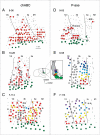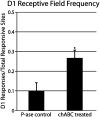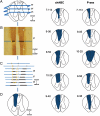Chondroitinase ABC promotes selective reactivation of somatosensory cortex in squirrel monkeys after a cervical dorsal column lesion
- PMID: 22308497
- PMCID: PMC3289303
- DOI: 10.1073/pnas.1121604109
Chondroitinase ABC promotes selective reactivation of somatosensory cortex in squirrel monkeys after a cervical dorsal column lesion
Abstract
After large but incomplete lesions of ascending dorsal column afferents in the cervical spinal cord, the hand representation in the contralateral primary somatosensory cortex (area 3b) of monkeys is largely or completely unresponsive to touch on the hand. However, after weeks of spontaneous recovery, considerable reactivation of the hand territory in area 3b can occur. Because the reactivation process likely depends on the sprouting of remaining axons from the hand in the cuneate nucleus of the lower brainstem, we sought to influence cortical reactivation by treating the cuneate nucleus with an enzyme, chondroitinase ABC, that digests perineuronal nets, promoting axon sprouting. Dorsal column lesions were placed at a spinal cord level (C5/C6) that allowed a portion of ascending afferents from digit 1 to survive in squirrel monkeys. After 11-12 wk of recovery, the contralateral forelimb cortex was reactivated by stimulating digit 1 more extensively in treated monkeys than in control monkeys. The results are consistent with the proposal that the treatment enhances the sprouting of digit 1 afferents in the cuneate nucleus and that this sprouting allowed these preserved inputs to activate cortex more effectively.
Conflict of interest statement
The authors declare no conflict of interest.
Figures



Similar articles
-
Spinal cord neuron inputs to the cuneate nucleus that partially survive dorsal column lesions: A pathway that could contribute to recovery after spinal cord injury.J Comp Neurol. 2015 Oct 1;523(14):2138-60. doi: 10.1002/cne.23783. Epub 2015 Jun 2. J Comp Neurol. 2015. PMID: 25845707 Free PMC article.
-
Reorganization of somatosensory cortical areas 3b and 1 after unilateral section of dorsal columns of the spinal cord in squirrel monkeys.J Neurosci. 2011 Sep 21;31(38):13662-75. doi: 10.1523/JNEUROSCI.2366-11.2011. J Neurosci. 2011. PMID: 21940457 Free PMC article.
-
Spatiotemporal trajectories of reactivation of somatosensory cortex by direct and secondary pathways after dorsal column lesions in squirrel monkeys.Neuroimage. 2016 Nov 15;142:431-453. doi: 10.1016/j.neuroimage.2016.08.015. Epub 2016 Aug 12. Neuroimage. 2016. PMID: 27523450 Free PMC article.
-
The reactivation of somatosensory cortex and behavioral recovery after sensory loss in mature primates.Front Syst Neurosci. 2014 May 12;8:84. doi: 10.3389/fnsys.2014.00084. eCollection 2014. Front Syst Neurosci. 2014. PMID: 24860443 Free PMC article. Review.
-
Cortical and subcortical plasticity in the brains of humans, primates, and rats after damage to sensory afferents in the dorsal columns of the spinal cord.Exp Neurol. 2008 Feb;209(2):407-16. doi: 10.1016/j.expneurol.2007.06.014. Epub 2007 Jul 6. Exp Neurol. 2008. PMID: 17692844 Free PMC article. Review.
Cited by
-
Spinal cord neuron inputs to the cuneate nucleus that partially survive dorsal column lesions: A pathway that could contribute to recovery after spinal cord injury.J Comp Neurol. 2015 Oct 1;523(14):2138-60. doi: 10.1002/cne.23783. Epub 2015 Jun 2. J Comp Neurol. 2015. PMID: 25845707 Free PMC article.
-
Passive exercise of the hind limbs after complete thoracic transection of the spinal cord promotes cortical reorganization.PLoS One. 2013;8(1):e54350. doi: 10.1371/journal.pone.0054350. Epub 2013 Jan 22. PLoS One. 2013. PMID: 23349859 Free PMC article.
-
Spinal cord injury - there is not just one way of treating it.F1000Prime Rep. 2014 Sep 4;6:84. doi: 10.12703/P6-84. eCollection 2014. F1000Prime Rep. 2014. PMID: 25343041 Free PMC article. Review.
-
Second-order spinal cord pathway contributes to cortical responses after long recoveries from dorsal column injury in squirrel monkeys.Proc Natl Acad Sci U S A. 2018 Apr 17;115(16):4258-4263. doi: 10.1073/pnas.1718826115. Epub 2018 Apr 2. Proc Natl Acad Sci U S A. 2018. PMID: 29610299 Free PMC article.
-
Cortical networks subserving upper limb movements in primates.Eur J Phys Rehabil Med. 2012 Jun;48(2):299-306. Epub 2012 Mar 12. Eur J Phys Rehabil Med. 2012. PMID: 22407009 Free PMC article. Review.
References
-
- Merzenich MM, et al. Progression of change following median nerve section in the cortical representation of the hand in areas 3b and 1 in adult owl and squirrel monkeys. Neuroscience. 1983;10:639–665. - PubMed
-
- Jain N, Catania KC, Kaas JH. Deactivation and reactivation of somatosensory cortex after dorsal spinal cord injury. Nature. 1997;386:495–498. - PubMed
-
- Darian-Smith C, Brown S. Functional changes at periphery and cortex following dorsal root lesions in adult monkeys. Nat Neurosci. 2000;3:476–481. - PubMed
Publication types
MeSH terms
Substances
Grants and funding
LinkOut - more resources
Full Text Sources
Other Literature Sources
Medical
Miscellaneous

